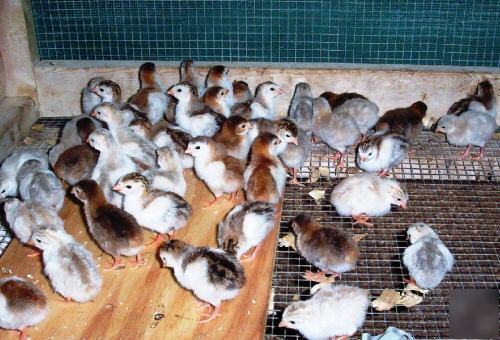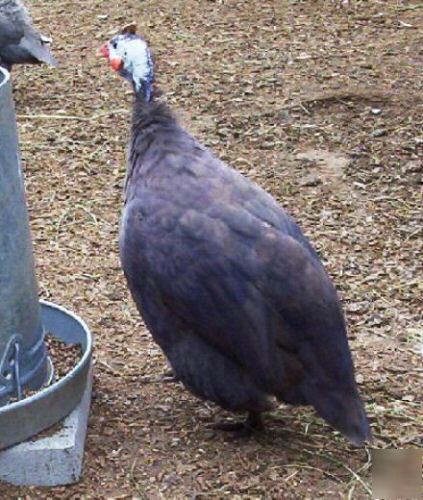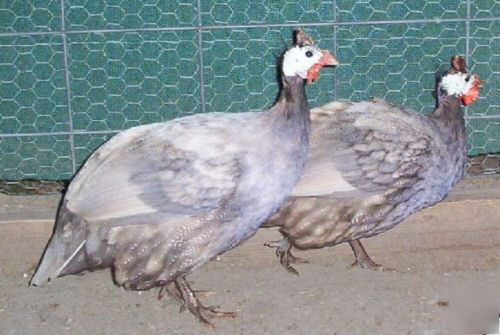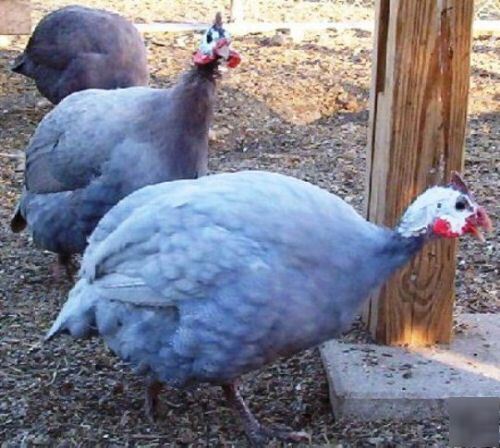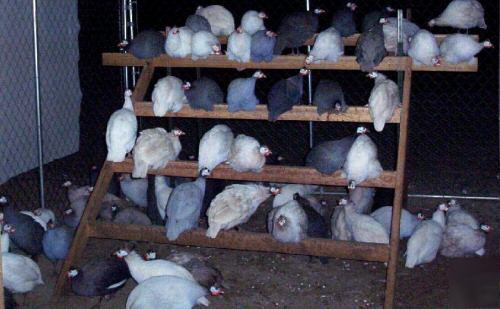|
28+ (plus eggtras when available) COLORED GUINEA FOWL HATCHING EGGS ((We have a pretty equal amount of each color guinea:)) Here is a list of the colors we have. All are first generation, purebred colors but now are breeding in mixed pens except for the ones listed as "penned separate or purebred": Slate - no dots - absolutely beautiful dusty slate blue with no dots and a cream cast across the back and a darker purplish colored neck ... very rare! Violet - solid colored violet with no dots Royal Purple - darker than the violets with dotting and barring Chocolate - brown mottled looking feathers with not dots - some purebred, some mixed Blonde - beautifil yellowish tan with no dots - very new color and very, very rare! Brown - beautiful brown color with dots - purebred (penned separate) Lavender - nice lavender color with uniform dots - purebred(penned separate) Pearl - this is the original color of guinea and is very nice, dark gray/black with dotting - purebred (penned separate) Porcelain - very soft blue feathering with a few dots - purebred (penned separate) Coral Blue - beautiful coral blue with a few dots Powder Blue - soft blue with no dots White - solid white every inch of them, they almost look albino - no dots Buff Dundotte - very beautiful buff color with uniform dots - some purebred and some will be mixed PLUS WE INCLUDE A FREE INSTRUCTION SHEET FOR HATCHING EGGS AND RAISING BABY POULTRY ALL OF OUR BIRDS ARE FED THE FINEST FEEDS AND WORMED REGULARLY. THEIR PENS AND GROUNDS ARE KEPT CLEAN. THEY ARE DUSTED WHEN NEEDED FOR RED MITES PINE SHAVINGS AND SAND ARE USED IN THE NEST BOXES TO KEEP THE EGGS AS CLEAN AS POSSIBLE OUR EGGS ARE KEPT ON AUTOMATIC EGG TURNERS IN A COOL PLACE UNTIL THEY ARE SENT TO YOU! WE ARE REGISTERED WITH THE TEXAS ANIMAL HEALTH COMMISSION FOR DOMESTIC AND EXOTIC FOWL. OUR CERTIFICATE OF REGISTRATION PERMIT NUMBER FR-002250...WE PARTICIPATE IN THE NATIONAL POULTRY IMPROVEMENT PLAN (NPIP). OUR FLOCK IS CERTIFIED POLLORIUM/TYPHOID FREE HAVE A GREAT DAY AND HAPPY HATCHING! Be sure to add me to your favorites list! FOR MORE INFORMATION ABOUT THE COLORS OF GUINEAS, THE BREED ITSELF OR ANY OTHER QUESTIONS, FEEL FREE EMAIL ME. Guinea Fowl, which are native to Africa, were domesticated there more than 4.000 years ago. The ancient Greeks and Romans not only domesticated them, but also featured them prominently in their gardens and aviaries and regarded them as a table delicacy. The Romans spread Guinea Fowl across Europe. With the fall of the Roman Empire, however, Guinea Fowl appear to have disappeared from northern and western Europe. In the 15th century, Portuguese traders introduced wild Guinea Fowl from West Africa into Europe and Guinea Fowl were again domesticated. They have been a popular domestic fowl ever since. Guinea Fowl appear in Greek mythology: When Meleager, who succeeded in killing the Caledonian boar, was killed, his sisters Deianira (wife of Hercules) and Gorge were put to death and turned into Guinea Fowl by Artemis. The tears that they shed showering their sable plumage with white spots. Dionysus pleaded with Artemis to undo her work, and the sisters were returned to their human form. To the untrained eye and from the aisle, it is not always an easy matter to determine the gender of Guinea Fowl. The calls made by adult birds are very useful in distinguishing the sexes. Guinea Fowl males utter a one-syllable call, usually repeated several times in succession: chit, chit, chit; females utter a two-syllable call, usually repeated several times in succession ("buck- wheat, buck-wheat, buck-wheat, buck-wheat"). A Guinea Fowl chick is properly referred to as a keet. Cock..............4.0 pounds Hen..........3.5 pounds Cockerel........3.5 pounds Pullet........3.0 pounds Weight is a breed characteristic. Any Guinea Fowl that deviates more than 20% either up or down from the weights listed above shall be disqualified from exhibition. For all Guinea Fowl, there is a 1-point cut for each 1/4 pound underweight. There is no point cut for the first 1/4 pound overweight, but there is a 1-point cut for each 1/4 pound thereafter. * Mismatched wattles: one tucked (carried flat, laterally, close to the side of the throat) and one cupped (concave, carried at a 90-degree angle to the side of the head) on young birds of either sex * A white feather in any section of the plumage of a colored Guinea Fowl * A colored feather in any section of the plumage of a white Guinea Fowl * Black flecking or a yellow cast to the plumage of a white Guinea Fowl is a serious defect. * One or more white primaries or secondaries in any colored Guinea Fowl * One or more colored primaries or secondaries in any white Guinea Fowl * Mismatched wattles: one tucked (carried flat, laterally, close to the side of the throat) and one cupped (concave, carried at a 90-degree angle to the side of the head) on young birds of either sex HEAD: Short and broad, topped with a triangular-shaped helmet, which slopes slightly downward at the rear. The area between the nostrils and the front of the helmet is flat. The face, back of the head, and the upper neck are devoid of feathers. At the back of the head, however, starting at the base of the helmet, there is a narrow band of hair-like plumage, pointing upward, that runs down the back of the head and neck to the hackle feathers. This band of hair-like plumage gets wider as it approaches and connects to the hackle. NOSTRILS: Prominent; a narrow band of thick skin crosses the bridge of the nose between the wattles. BEAK: Short, stout, and well curved. EYES: Large, round, very alert; lashes - even, prominent, well-formed. WATTLES: Stiff wide, smooth, and free from folds or wrinkles. Both wattles cupped (concave and carried at a 90-degree angle to the side of the head). NECK: Lower neck and hackle covered with small, fine, and narrow feathers. BREAST: Well rounded and prominent, carried above horizontal, and curving in an unbroken line to the hocks. BACK: Very broad and forming a descending curve from the base of the neck to the tail WINGS: Large, wide, and strong, well tucked-in and carried horizontally. No points will be deducted for BODY: Fairly long, deep, well rounded, and solid TAIL: Relatively short and carried low THIGHS: Medium in length, lower thigh not visible from the aisle SHANKS and TOES: Shanks relatively short and not feathered; feet with four straight, well spread, and strong toes. Males and females, both without spurs. Same as male, except that the female's helmet is smaller than that of the male, whose helmet is more elongated and broader at the rear than the female's. The nostrils on the female guinea fowl are less prominent than on the male. The wattles on the female Guinea Fowl can be either tucked (carried flat, laterally, close to the side of the throat) or cupped (concave, carried at a 90-degree angle to the side of the head). When showing, the carriage of the Guinea Fowl is upright, although the female Guinea Fowl's stance is not as upright as that of the male. Plumage is blue-gray throughout, generously and regularly marked with pearl-like white spots or wavy bars of white, depending on the section of the bird in question. The largest and most circular pearls on the bird appear in the fluff feathers at the rear of the bird. The general impression is one of a spotted gray bird. Undercolor is dark slate. Indistinct barring and/or indistinct pearls in the wings is a defect. BEAK: Reddish-horn, darker at the base HELMET: Light brown; nearly black in young birds WATTLES: Coral red, some white on underside of male wattles and at the outer top of the female wattles is permissible. HEAD: A crescent-shaped patch of featherless bluish-white skin, beginning in front of the eyes and extending back to the band of hair-like plumage at the back of the neck, covers the side of the face. Bluish-black skin covers the remainder of the head, neck, and throat, down to the hackle - except for the horn and the immediate area around its base. The area from the base of the beak to the base of the helmet is coral red, matching the color of the wattles. HACKLE: The hackle and the front of the lower neck show fine, blue-gray feathers without pearls or bars. When seen in sunlight, these feathers show some iridescence. BACK: The back and shoulders are bluish-gray, with small pearls, which increase in size as one approaches the tail. TAIL: The tail and coverts are bluish-gray, showing well rounded pearls. BREAST: The breast and lower body are bluish-gray, with good-sized and well rounded pearls throughout. The largest and most circular pearls on the bird appear in the fluff feathers at the rear of the bird. WINGS: Primaries: Upper web is light bluish-gray, marked primarily with parallel wavy bars of white on the inner primaries, and pearls in rows on the outer primaries. Lower web is marked with pearls at regular intervals. Secondaries: Outer edge of upper and lower webs marked with regular pattern of short parallel white bars; central part of each feather is marked by three to five longitudinal rows of pearls. LEGS and TOES: Dark slate, mottled with dusky orange. Judges should keep in mind that a female Guinea Fowl in heavy production may have faded leg color. The pattern is identical to that of the Pearl, the ground color of the plumage is light gray, or lavender. Shanks and toes are light gray to orange. Indistinct barring and/or indistinct pearls in the wing feathers is a defect. Plumage is pure white throughout all sections, in both male and female. Black hair feathers on the lower neck and hackle, however, are acceptable, but not preferred. Black flecking or a yellow cast to the plumage is a serious defect. Shanks and toes are orange; spotty shanks and toes are a defect. The eyes are light bay to brown. (please look at our rules and privacy policy) |
Jeanshort@machine--tools.com (Jean Short) for additional information. This email is used for forwarding to newsgroup user.
